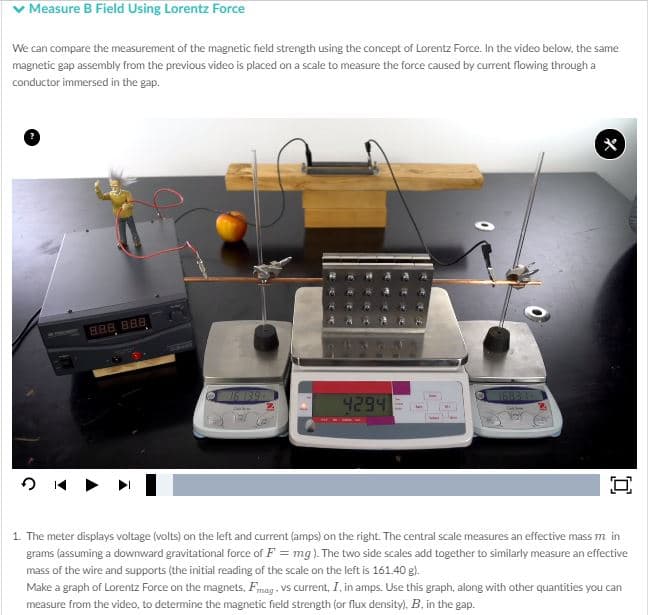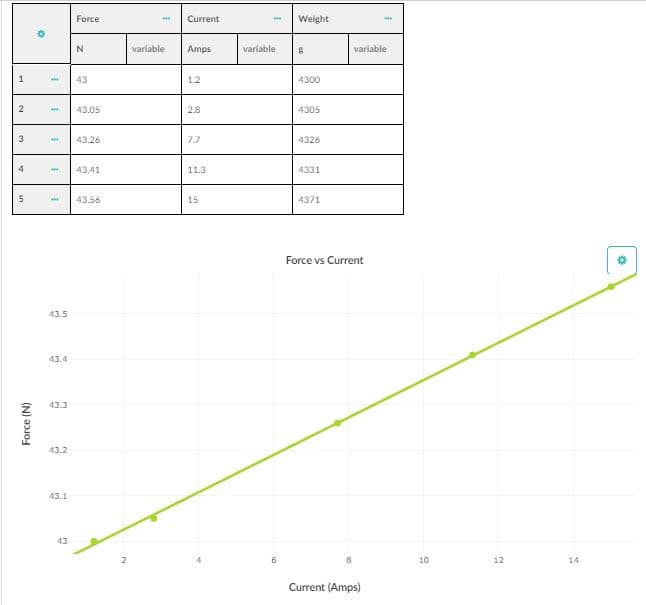v Measure B Field Using Lorentz Force We can compare the measurement of the magnetic field strength using the concept of Lorentz Force. In the video below, the same magnetic gap assembly from the previous video is placed on a scale to measure the force caused by current flowing through a conductor immersed in the gap. 义 4294 1 The meter displays voltage (volts) on the left and current (amps) on the right. The central scale measures an effective massS m in grams (assuming a downward gravitational force of F = mg). The two side scales add together to similarly measure an effective mass of the wire and supports (the initial reading of the scale on the left is 161.40 g). Make a graph of Lorentz Force on the magnets, Fmag- VS current, I. in amps. Use this graph, along with other quantities you can measure from the video, to detemine the magnetic field strength (or flux density). B., in the gap.
v Measure B Field Using Lorentz Force We can compare the measurement of the magnetic field strength using the concept of Lorentz Force. In the video below, the same magnetic gap assembly from the previous video is placed on a scale to measure the force caused by current flowing through a conductor immersed in the gap. 义 4294 1 The meter displays voltage (volts) on the left and current (amps) on the right. The central scale measures an effective massS m in grams (assuming a downward gravitational force of F = mg). The two side scales add together to similarly measure an effective mass of the wire and supports (the initial reading of the scale on the left is 161.40 g). Make a graph of Lorentz Force on the magnets, Fmag- VS current, I. in amps. Use this graph, along with other quantities you can measure from the video, to detemine the magnetic field strength (or flux density). B., in the gap.
Related questions
Question
100%
Calculate the magnetic field strength from the slope of the graph and other measurements.

Transcribed Image Text:Measure B Field Using Lorentz Force
We can compare the measurement of the magnetic field strength using the concept of Lorentz Force. In the video below, the same
magnetic gap assembly from the previous video is placed on a scale to measure the force caused by current flowing through a
conductor immersed in the gap.
76139
4294
1683
1. The meter displays voltage (volts) on the left and current (amps) on the right. The central scale measures an effective mass m in
grams (assuming a downward gravitational force of F = mg). The two side scales add together to similarly measure an effective
mass of the wire and supports (the initial reading of the scale on the left is 161.40 g).
Make a graph of Lorentz Force on the magnets, Fmag- VS current, I, in amps. Use this graph, along with other quantities you can
measure from the video, to determine the magnetic field strength (or flux density), B, in the gap.

Transcribed Image Text:Force
Current
Weight
N
variable
Amps
variable
variable
1
43
1.2
4300
2
43.05
2.8
4305
3.
43.26
7.7
4326
43.41
11.3
4331
5.
43.56
15
4371
Force vs Current
43.5
43.4
43.3
43.2
43.1
6
10
12
14
Current (Amps)
Force (N)
an
Expert Solution
This question has been solved!
Explore an expertly crafted, step-by-step solution for a thorough understanding of key concepts.
This is a popular solution!
Trending now
This is a popular solution!
Step by step
Solved in 4 steps
